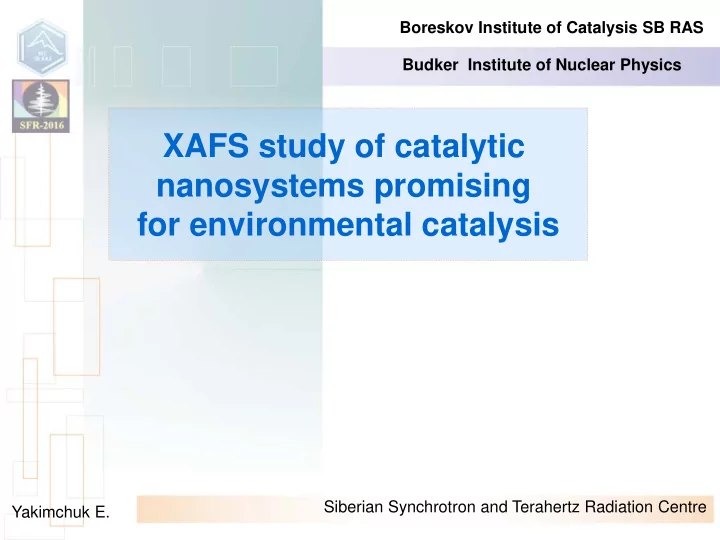

Boreskov Institute of Catalysis SB RAS Budker Institute of Nuclear Physics XAFS study of catalytic nanosystems promising for environmental catalysis Siberian Synchrotron and Terahertz Radiation Centre Yakimchuk E.
Application area: Industrial useful substratums: Acid conversion Methane CH 4 + CO 2 2CO + 2H 2 of a synthesis gas Membrane d pores = 2-1000 nm Basicle principle of formation Active component TIPS RAS TiO 2 Catalytic conversion of hydrocarbons into hydrogen containing Side of membrane gas
Tasks: Objects to analized with complex methods: - Original catalitics systems - Calcined with different conditions systems Application systems Pd-Co/TiO 2 Pd-Mn/TiO 2 To understand principle of formation bi-metall active centres of supports and there structural features
Tasks of XAFS method: With XAFS-spectroscopy we can: - Establish a symmetry of the immediate environment, charge state of atoms and local structure Using anouther methods such as X-ray Photoelectron Spectroscopy and XRF spectroscopy we can know: - Elements composition on a surface - Size of particles - Phase state
Systems with Pd-Co. Preparation: Coprecipitation in toluene with the Parents compounds: н -butoxide Ti addition of an alcohol-water mixture for PdCo( μ -OOCMe) 4 (NCMe) hydrolysis Next steps 2) With Ar 1) Drying with 5 hours, 550 0 С 25 0 С (gel) 3) Microwave, then Ar 2 hours, 550 0 С
Study: XRF spectroscopy Only for T iO 2
Systems with Pd-Co: Pd-k edge XANES (Pd-K) and FT of Pd for 1%Pd-2%Co/TiO 2 and comparison sample: а) 1%Pd-2%Co - previous (gel, drying 25 С) ; b) 1%Pd-2%Co/TiO 2 (550 С, microwave, calcination); c) 1%Pd-2%Co/TiO 2 (550 С, air); d) 1%Pd-2%Co/TiO 2 (550 С, Ar); e) PdO – comparison oxide; f) Pd – foil.
Systems with Pd-Co: Co-k edge XANES (Pd-K) and FT of Co for 1%Pd-2%Co/TiO 2 and comparison sample : а) 1%Pd-2%Co - previous (gel, drying 25С); (550 С, b) 1%Pd-2%Co/TiO 2 microwave, calcination); (550 С, c) 1%Pd-2%Co/TiO 2 air); (550 С, d) 1%Pd-2%Co/TiO 2 Ar); e) Co 3 O 4 – comparison oxide ; f) Co – foil.
System with Pd-Co: Pd-O Pd-Pd Pd-Me model The main parts of Pd stay in oxide phase. It's a result from 2.0 Ǻ 3.04 Ǻ 3.34- 3.4 Ǻ comparing distances and 3.6-3.8 0.9-1.0 4.8-5.1 #1 Me=Pd coordination numbers with crystallographic data 2.0 Ǻ 3.04 Ǻ 3.4- 3.6 Ǻ 4.8 -5.1 3.6-3.8 0.9-1.0 #2 Me=Co Co-O Co-Co Co-O-Me Co-O-Me model 1.96 Ǻ 2.85 Ǻ 3.32 Ǻ 3.76 Ǻ sample Presumably we saw formation 3.9-4.1 0.2 0.6 0.3 of non-stoichiometric compounds with structural Co-Co Co-Me Co-Ti properties similar mixed oxides model Co-Ti и Pd-Co 2.99 3.39 3.74 CoTiO 3 2.83 3.38 - PdCoO 2
System with Pd-Mn. Preparation: Precursor Sol-Gel method Gel formation Drying (Ar) and calcinization (500 0 C) Pd (μ -OOCMe) 4 Co(OH 2 ) XRF spectroscopy Only for T iO 2
System with Pd-Mn: Pd-k edge XANES (Pd-K) and FT of Co for Pd-Mn/TiO 2 and comparison sample a) Pd-Mn/TiO 2 - gel b) Pd-Mn/TiO 2 – oxide, T=500C c) PdO comparison sample d) Pd – foil Pd 0 #1 – Pd- #2 – Pd- PdO № Mn/TiO 2 Mn/TiO 2 metall (gel) (metall) R, N R, N R, N R, N Å Å Å Å - 1.9 2.0 2.0 Pd- 4.1 3.8 4.0 --- - 8 0 1 O - 2.9 3.0 3.0 2.7 1 Pd- 2.0 2.5 4.1 9 3 2 6 2 Pd 3.5 - 0- ~1. 3.4 3.4 Pd- 3.4 8.0 --- - 3.5 0 5 3 Pd - 5
System with Pd-Mn: Mn-k edge XANES (Pd-K) and FT of Co for Pd-Mn/TiO 2 and comparison sample : а) Pd-Mn/TiO 2 - gel б) Pd-Mn/TiO 2 – oxide, T=500C в) Mn0 (.*0.5) г) MnO (.*0.5) д) Mn 3 O 4 (*0.5) е) Mn 2 O 3 (*0.5) ж) MnO 2 (*0.5) Pd-Mn/TiO 2 - gel R Mn-O =~2.11Å, N=~4.9. Pd-Mn/TiO 2 T=500C R Mn-O =~2.03 Å, N=~4.5; R Mn-Me (Mn, Ti) =~2.96-3.02Å, N=~2; R Mn-Me (Mn, Ti) =~3.7-3.8Å, N=~1 Anatize R Ti-O =~1.94-1.98Å, N=6; R Ti-Ti =~3.0-3.04Å, N=4; R Ti-Ti =~3.74-3.78Å, N=4
Results: For Pd-Co: - We supposed that systems has strong interraction between Pd and Co in a precipitation stage. In this situation Co take place in strucrure of supporte to locate atoms of Pd. They formatited a mixed oxide that are not non-stoichiometric For Pd-Mn: - As a result we supposed that for gel state for Pd-Mn systems formed to a defect nanophase PdO, that consists of basic Pd-Mn comples and PdO - We saw deffects of MnO x nanophase with stabilization of ions with local deffects
Thanks for your attantion
Recommend
More recommend